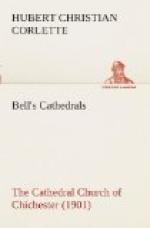#Simon Fitz Robert#, or #Simon of Wells# (1204-1207), was a bishop whose favour with the king (John) enabled him to do much for the see. He had held a post in the Royal Exchequer, and had been guardian of the Fleet Prison as well as Provost of Beverley and Archdeacon of Wells. The benefactions he obtained were various. A charter was granted by which the see should hold its property free from impost, under the protection of the king. The bishop, with his dean and chapter, were practically exempted from the jurisdiction of the local civil courts and from the payment of customs and tolls within the same sphere. Within the bounds of the property owned by the see they were to rule without restraint, and in the presence of a royal official “the view of Frank Pledge was to be held in the bishop’s court.” In the patent rolls of King John there are two entries, dated 1205 A.D. and 1206 A.D., by which the bishop was granted permission to take Purbeck marble for the repair of his church without hindrance, from the coast of Dorset to Chichester. [32] But precautions were taken to prevent any of the material thus obtained from being used elsewhere. A further grant, the evidence of which is now removed, allowed the chapter to build premises beyond the precincts northward, which encroached twelve feet into the roadway now known as West Street. A row of lime-trees now stands where these houses remained till the middle of the last century. For six years after Simon’s death John kept the see vacant, and during the interim enjoyed the temporalities.
[32] See Walcott, p. 15, note c, May 24th, 1207.
#Richard Poore# was then consecrated bishop in 1215. He had been Dean of Old Sarum. But after occupying the see for no more than two years, he was translated to Salisbury.
#Ranulf of Warham# (1217-1224) bequeathed some property to the see [33]; but otherwise he did little, except as a fortunate collector of cattle, for the support of which his successor provided pasturage.
[33] Stephens, p. 57.
#Ralph Neville# (1224-1244) was a bishop of more than local celebrity. Like Langton, the archbishop, he withstood the demands which the papacy and Henry III. made in their endeavours to impoverish the Church in England. For this opposition the king removed him temporarily from the post of Chancellor of the Realm, a position he held from 1226 to 1240. His “fame rests more upon his repute as a statesman faithful in many perils, and a singular pillar of truth in the affairs of the kingdom.” [34] He succeeded in procuring the payment to the Church of tithe from some royal properties which had been withheld, and left provision for the supply of twelve quarters of wheat annually to the poor in Chichester. Some, notes preserved in the cathedral records lead to the supposition that the portion of the old central tower above the roof and up to the parapet at the foot of the spire was built, or at least begun, during Ralph’s




